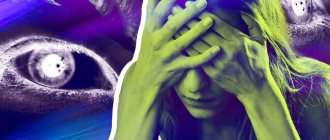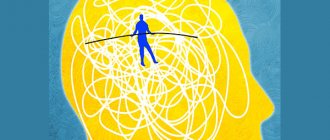Neurosis-like schizophrenia is a chronic disease with fluctuations in intensity, which is closest to schizotypal personality disorder (ICD-10 code F21.3). The clinical picture contains psychopathological manifestations similar to neurotic ones.
In foreign sources, slowly and relatively favorably developing psychoses of endogenous origin were called differently. Such schizophrenia had the following synonymous names:
- soft;
- sanatorium;
- pseudoneurotic;
- sluggish.
According to the American classifiers (DSM), the symptoms do not fully meet the criteria for classical schizophrenia. The disease is classified as borderline personality disorder, that is, character pathology.
Risk factors and causes of development
The issue of early detection of borderline violations remains open, since it is impossible to identify specific causes of development. The following risk factors dominate:
- heredity – the presence of a schizophrenia spectrum disease in close relatives;
- identified other mental disorders in relatives, including addiction syndrome (mainly from alcohol) and manic-depressive psychosis;
- spontaneous genome mutations in a particular individual;
- imbalance between the functioning of neurotransmitter systems in the brain;
- disturbance of human psychomotor development in early childhood and/or pathology of pregnancy in the mother;
- disharmonious socio-psychological conditions in which a child grows up, including orphanhood;
- male gender and young age are more questionable factors, since the development of pathology can occur at any period of life.
Most patients seek help before the age of 35, as symptoms interfere with daily life and reduce ability to work. About 65% of patients have higher education.
Vandysh M.V. About some clinical and social characteristics of patients with pseudoneurotic schizophrenia // Russian Psychiatric Journal. 2008. No. 2.
Diagnosis and treatment
During the initial diagnosis, the doctor examines the patient and talks with him. After this, relatives can be interviewed. The psychiatrist must see the picture from different sides, and not just from the words of the patient, who may be inadequate during an exacerbation. It is also necessary to find out whether a person has a genetic predisposition to such disorders. To do this, it is determined whether there were schizophrenics and mentally ill people in the family.
Diagnostics includes standard laboratory and instrumental procedures, including MRI, CT, EEG, tests, etc. Various psychotherapeutic tests are also prescribed. To make an accurate diagnosis, you need to differentiate it from similar disorders. This may require more than one month of observation of the patient.
Treatment is based on psycho- and drug therapy. The patient comes to individual and group sessions with a psychiatrist and also takes antipsychotic medications. The dosage and type of medicine are determined by the patient's condition. Atypical antipsychotics are usually prescribed. Relatives of the patient also come for consultation with a psychotherapist, who will have to learn how to interact with a schizophrenic.
Features of pseudoneurotic schizophrenia
Symptoms appear spontaneously without a clear connection with external factors. Over time, manifestations may increase or disappear on their own. The clinical picture is ambiguous, as it may correspond to other diseases. Only a psychiatrist can verify the condition.
Behavior
The intensity of manifestations varies depending on the severity of the disorder in a particular person. Despite individual differences, the behavior of patients may have the following general characteristics:
- Obsessive (obsessive) actions of high strength. People perform their characteristic rituals for a long time, not paying attention to the people around them. For example, washing your hands three times is a prerequisite for leaving the house.
- Removal from society is the autization of personal attitudes. The circle of communication is limited to relatives or single friends. Communication takes place more out of necessity, which does not make patients unhappy.
- Strange manner of speech using abstract phrases.
- Atypical style of clothing. Often simply untidy, indicating complete indifference to the opinions of other people.
- Ignoring conventions, rules of behavior, etiquette.
- Narrowing the range of interests.
- Refusal to eat to the point of anorexia or bizarre dietary habits. For example, a person begins to eat only herbs or raw foods. The motivational reasons for such tricks are illogical - “I want my face to look like a cat’s face.”
- Monotonous asthenia is a neuropsychic weakness that does not improve after rest.
Any anxiety acts as a catalyst for anxiety-phobic syndromes. It becomes difficult for a person to respond adequately in simple social situations. Any changes in psycho-emotional status are reflected in behavior.
Psycho-emotional and neurotic manifestations
Neurosis-like symptoms arise against a persistently altered psychopathological background. During periods of exacerbation the following symptoms are typical:
- daily mood swings for no reason;
- anxiety and restlessness intensify in unfamiliar conditions or crowded places;
- tendency to reflect;
- obsessive doubts and obsessions with contrasting content;
- several different emotions appear together or replace each other too quickly, and their color also changes unpredictably;
- reactions to ordinary stimuli are inconsistent or generally inert;
- feelings of guilt, anger, fear are distorted, but it is extremely difficult to cope with them;
- anhedonia – decreased ability to experience pleasure;
- pronounced insurmountable phobias of strange content, for example, fear of the color red or the letter “O”;
- sensory-emotional experiences can be perceived by a person as a manifestation of weakness, so he tries to refuse them;
- Hypochondria is an excessive concern about one’s health, which manifests itself in the form of fanciful complaints (“bones are crumbling,” “blood flows from one hand to another”).
In severe cases of the disorder, obsessive-phobic experiences reach such strength that some patients begin to show signs of suicidal behavior. The first changes can be noticed in adolescence, since obsessions usually remain the same, but their severity worsens.
FINK Gennady Fishelevich. SLUGGY NEUROSIS-LIKE SCHIZOPHRENIA (CLINICAL-SYSTEM-ANALYTICAL STUDY). Abstract of the dissertation for the degree of Doctor of Medical Sciences
Sensorimotor perception
A person’s perception of his own body changes, usually in a negative way. Among the symptoms, the following changes predominate:
- depersonalization – a violation of a person’s self-perception, in severe cases – a feeling of loss of one’s own “I”;
- dysmorphomania – a painful belief in the presence of physiological defects or deficiencies, reaching the level of delusional disorders;
- pathological belief in (imaginary) ugliness becomes a barrier to social interaction;
- alleged shortcomings and defects are masked with the help of clothing, perfume, and unjustified surgical interventions.
Sluggish schizophrenia tends to progress and transform into a more severe course. In adolescence, such individuals may suffer from eating disorders (bulimia, anorexia) due to an unreasonable disgust for their body.
Thinking
Symptoms are grouped into a single clinical picture, accompanying each other. With a more detailed diagnosis, the doctor also identifies thinking disorders:
- lack of concentration;
- a fine line between the perception of real and fictional;
- inability to hold focused thoughts for a long time;
- a person does not see the difference between thoughts that are similar in emotional color or content;
- weakening of the ability to adequately understand any concepts;
- change in self-perception;
- the constant presence of a “motivating” attitude, which triggers an unstoppable sequence of obsessive thoughts;
- the patient does not recognize antisocial behavior, so their actions often cause confusion among others.
Excessive preoccupation with one's own health or appearance is reflected in thinking, which becomes pathological. At the same time, the patient does not understand the depth of the problem.
Symptoms and signs
Symptoms of schizophrenia manifest themselves in the form of hallucinations and delusions. The patient can hear sounds and voices that are not audible to others, due to the absence of such, the belief that his actions and thoughts are controlled by some unknown force from the outside. The patient is often confident that he himself is a great, famous person. Schizophrenia symptoms and signs also manifest themselves in the expression of inappropriate emotions, for example, a person can laugh, while having received tragic news, the patient becomes depressed or completely indifferent to the world around him.
How to distinguish neurosis from schizophrenia
The main differences lie in the etiology of the diseases. Neurosis usually manifests itself after prolonged anxiety or stress. Also, the “activator” can be the death of someone close to you.
The main difference between neurosis and schizophrenia is the preservation of the patient’s personality. He understands his illness, strives to get better, and visits doctors. At the same time, neurosis is usually easily cured and lasts for a very limited time, while schizophrenia can last a lifetime.
The symptoms of both disorders are similar only at the initial stage. And then they begin to differentiate greatly, since even in the mildest form, schizophrenia leaves a mark on the personality and can greatly deform it.
Diagnosis F 20.3 Undifferentiated schizophrenia
A psychotic condition that meets the basic diagnostic criteria for schizophrenia, but does not correspond to any of its forms classified in subheadings F20.0-F20.2, or exhibits features of more than one of the above forms without a clear predominance of a specific set of diagnostic characteristics.
Antitypical schizophrenia
Excluded:
- acute schizophrenia-like psychotic disorder (F23.2)
- chronic undifferentiated schizophrenia (F20.5)
- post-schizophrenic depression (F20.4)
Diagnosis F 20.2 Catatonic schizophrenia
The clinical picture of catatonic schizophrenia is dominated by alternating psychomotor disturbances of a polar nature, such as oscillations between hyperkinesis and stupor or automatic submission and negativism. Stiff postures can persist for a long time. A notable feature of the condition may be cases of sudden agitation. Catatonic manifestations can be combined with a dream-like (oneiric) state with vivid stage hallucinations.
Catatonic stupor
Schizophrenic:
- catalepsy
- catatonia
- waxy flexibility
Depression
Since the beginning of the twentieth century, it has been generally accepted that an affective disorder such as depression is quite common in schizophrenia. At the same time, the point of view of E. Kraepelin (1896) is known about the existence of a contradiction between “dementia praecox” and “manic depression”, a relative dichotomy suggesting the pathogenetic opposition of these pathological conditions. E. Bleuler (1911), on the contrary, included symptoms of depression, in particular anhedonia, among the main manifestations of schizophrenia. The situation was further complicated by the hypothesis of J. Kasanin (1933) about the existence of “schizoaffective psychoses”, in the clinical picture of which manifestations of schizophrenia and affective psychosis seemed to be mixed, however, we note that the term “schizoaffective disorder” was used to a greater extent when signs of schizophrenia were combined with manic states.
At present, the question of whether depression should be considered an integral part of the process of schizophrenia or whether it is an independent mental disorder, a kind of phenomenon conditionally independent of schizophrenia, remains open. However, according to most authors, depression in schizophrenia still does not have a specific etiology (Burrows G., Norman T., 2001).
Recently, the frequency of depression in schizophrenia is often explained by the general increase in patients with depression in the population (Rendon M. et al., 2000).
In almost 50% of cases, patients with schizophrenia who are in the acute phase of the disease show clear symptoms of depression, which weaken in severity as they recover from psychosis. Depression as a pre-manifest disorder is observed in 40% of patients with schizophrenia, and as a prodromal disorder in 20-60%. In the chronic course of schizophrenia, depression is registered in 25% of patients, in thymopathic remissions - in 20% (Ivanov M.V., 2007).
Frequency of occurrence of depression at various stages of schizophrenia
- Prodromal phase - 40%
- Acute phase - 50%
- Stage of remission - 40%
- Remission - 20%
The prognostic significance of depression in schizophrenia is unclear; on the one hand, pronounced affective disorders in schizophrenia partly indicate a favorable prognosis for its course and partly indicate shallow damage to brain structures; on the other hand, depression in schizophrenia is often accompanied by suicidal thoughts. In addition, it can contribute to the resistant course of the disease, its frequent relapses and prolong the length of hospitalization. There is no doubt that the psychopathological structure of depression plays an important role in predicting the course of schizophrenia.
Depressive disorders that arise as schizophrenia progresses are extremely variable in the structure of clinical manifestations. However, they should be distinguished from the manifestations of the sedative effect of antipsychotics and the negative symptoms of schizophrenia. After all, the symptoms of depression and manifestations of negative symptoms are in many ways similar to each other, and in both cases anhedonia, low mood, anergy, motor retardation, poor speech, poor concentration, and a desire for loneliness and social isolation are noted. In addition, depression may be a consequence of a reaction to positive psychotic symptoms such as delusions and hallucinations, or accompany akathisia and akinesia that have developed while taking antipsychotics. Let us note that akathisia increases the severity of suicidal tendencies and has a peculiar, mildly expressed dysphoric coloration of depressive symptoms.
When making a differential diagnosis, it should be borne in mind that a depressive episode, more than schizophrenia, is characterized by feelings of guilt, low self-esteem, dysfunction of the autonomic nervous system, anorexia and a peculiar sleep disorder.
Modern views on the role of depression in schizophrenia
- Depression is a manifestation of the underlying pathological process characteristic of schizophrenia;
- Depression is a consequence of the cyclical course of schizophrenia, the frequency of its exacerbations;
- Depression is a sign of a relatively favorable course of schizophrenia, the result of a transition of symptoms from the paranoid register to a “softer” affective one;
- Depression aggravates the course of psychosis and delays the formation of the remission phase;
- Depression is comorbid and “cosyndromic” with schizophrenia;
- Postpsychotic depression is a pathological defensive reaction of the individual, a consequence of awareness of mental disorder, social problems and limitations caused by schizophrenia (psychodynamic theory);
- Depression is a cause of suicide in schizophrenia;
- Postpsychotic depression is a biological reaction to psychosis that depletes the body;
- Depression is a consequence of the sedative effect of antipsychotics, hyperprolactinemia and extrapyramidal symptoms;
- Depression is the result of drug-induced pathomorphosis.
In the premorbid period, and especially during the prodrome of schizophrenia, the severity of depression in some cases is comparable to a fairly severe affective disorder.
As the manifestation of schizophrenia intensifies, signs of apathy and dysphoria begin to appear in depression to an increasing extent (Vovin R.Ya., 1995). In general, apathy, psychomotor retardation, a feeling of weakness and helplessness, hypochondriasis, and a kind of mental anesthesia are characteristic of schizophrenia. Perhaps less often, depression in this disease manifests itself as dysphoria.
In almost 60% of cases, in the depressed state of patients with schizophrenia, one can identify a component of a meaningless threat, a feeling of an impending vague catastrophe that does not have a clear plot.
According to S. Siris (1991), antipsychotics cannot provoke the onset of severe depression, since clinical experience shows that as positive psychotic symptoms are relieved, a weakening of the severity of depressive symptoms is also noted. In support of his hypothesis, the author also cites the fact that there is no correlation between the concentration of an antipsychotic in the blood plasma and the severity of depression. Proponents of the opposite point of view point out that depression that develops as a result of taking antipsychotics is the result of the latter’s peculiar influence on the dopamine system (Harrow M. et al., 1994).
Depression in schizophrenia increases the risk of suicide. Between 10 and 15% of people with schizophrenia commit suicide and about 40% attempt suicide. A number of studies have found a correlation between the severity of distress, feelings of hopelessness, understanding of the severity of the emerging mental disorder and readiness for suicide (Kim Y. Et al., 1997; Caroll A. et al., 1999).
The risk of suicide is highest in the first 5-10 years of the disease, the first days of hospitalization (50% of suicides occur in a hospital), after the first discharge from the hospital; 20-40% of patients attempt suicide impulsively, and a feeling of hopelessness, more than symptoms of psychosis, accompanies completed suicide,
The patient’s suicidal readiness is influenced by patients’ inflated expectations and their overestimation of their capabilities (Goffman A.G., Ponizovsky P.A., 2006).
Particularly dangerous in terms of suicide is the so-called post-psychotic depression, which manifests itself within 6 months after the first psychotic episode. This fairly persistent depression is registered in 25-50% of cases, and according to some sources, even in 80% of patients (Ivanov M.V., 2007).
In the clinical picture of postpsychotic depression, attention is drawn to the peculiar “lethargy” of patients; typical complaints are about feelings of melancholy and “lack of emotions.” At the same time, patients lose interest in communication.
Among the causes of postpsychotic depression, attention should be paid to the stigma of the disease, poor relationships in the patient’s family, limited interpersonal connections and difficulties arising in the process of study or work, alcohol or psychoactive substance abuse.
As a rule, postpsychotic depression is protracted and resistant to drug therapy.
As noted above, the treatment of depressive spectrum disorders in schizophrenia is quite a difficult task.
Controlled clinical trials have shown that adding tricyclic antidepressants to antipsychotics has no effect on the severity of depression (Rifkin A., Siris S., 1987). Moreover, in some works at the end of the twentieth century, authors wrote about the ability of antidepressants to cause exacerbation of psychosis and the appearance of severe depression after recovery from it (Levinson D. et al., 1999). Some scientists believe that the prescription of antidepressants can be justified only at a certain stage of antipsychotic therapy: at the time of acute psychosis it is inappropriate, on the contrary, at the stage of postpsychotic depression it is legitimate. In all cases, treatment of depressive states in patients with schizophrenia requires an integrated approach, which includes, in addition to drug therapy, adequate psychotherapeutic assistance.
Mechanisms of the antidepressant effect of atypical antipsychotics
- Positive effect on the serotonergic system
- Reducing the severity of cognitive impairment
- Reducing the severity of craving for alcohol and a number of psychoactive substances
- Absence of pronounced extrapyramidal symptoms
- Positive impact on the psychosocial status of the patient
- Compliance with the patient
According to some authors, a number of modern atypical antipsychotics, for example, risperidone, olanzapine, ziprasidone and, especially, aripiprazole, have an antidepressant effect. At the same time, some researchers talk about the ambiguity of the effect of these drugs on the manifestations of depression, suggesting in this case the possibility of the emergence of different variants of its dynamics: “harmonious”, “unmasked” and “post-attack” depression.
Forecasts
The disease has a favorable treatment prognosis. Most patients achieve a state of stable remission, which can last for years. Thanks to pharmacotherapy and psychotherapy, the patient gets rid of phobias, restores, as far as possible, mental functions, volitional and emotional spheres, establishes social connections, returns to society and the family. However, to prevent relapses and relapses, it is necessary to continue taking the medications and follow all the recommendations of the attending physician.
Causes of schizophrenia in women
There is currently no sufficient data on the causes of schizophrenia and the paths of its development, but as we have already stated earlier, a large number of specialists in psychiatry and psychoanalysis attach the main importance in its occurrence to the patient’s heredity. Also, the nature and course of the disease largely depends on the gender of the patient. The reasons for this are the cyclical nature of neuroendocrine processes associated with menstrual function, pregnancy, childbirth, but the prognosis, in general, is also considered favorable. The main causes of schizophrenia in women most often lie in childhood or adolescence - during this period, malignant forms of schizophrenia develop.
Diagnosis F 20.5 Residual schizophrenia
A chronic stage in the development of the disease of schizophrenia in which there has been a clear transition from an early stage to a late stage, characterized by long-term (though not necessarily irreversible) “negative” symptoms such as psychomotor retardation; low activity; emotional dullness; passivity and lack of initiative; poverty of speech content; poverty of nonverbal interactions through facial expressions, eye expression, intonation and posture; decreased self-care and paucity of social activities.
Chronic undifferentiated schizophrenia
Residual schizophrenic state
Causes of schizophrenia
Several theoretical assumptions have been highlighted:
- Unfavorable hereditary aspects. It has been proven that people who have relatives with schizophrenia are more likely to develop this disease. However, it has not yet been possible to establish exactly what the essence of the predisposition to schizophrenia is;
- Certain violations in the educational process. Some examples that can be considered sufficient confirmation of this assumption are available in the psychoanalytic literature. At the same time, there are practically no serious laboratory, clinical and scientific studies and specific statistics in favor of this assumption. ;
- Factors of shock and stress. Proponents of this hypothesis argue that the trigger in this situation can be a pronounced mental or physiological stressful situation;
- The role of age-related crises. The advancement of this theoretical assumption is associated primarily with the appearance of the works of the famous psychoanalyst Erik Homburger Erikson about age-related crisis periods and the impact they have on human personality. This hypothetical assumption is supported by the fact that the disease often manifests itself during the period of departure from parental care and the beginning of separate life activities - at seventeen to nineteen years. In the conditions dictated by modern civilized society, perhaps at age: twenty to twenty-five years.
Is it possible that neurosis will develop into schizophrenia?
In some complex cases, due to the vagueness of the primary symptoms, it is not possible to immediately make a correct diagnosis. Gradual manifestations of sluggish schizophrenia, at the initial stage of the disease, can be very similar to neurosis.
Neurosis and schizophrenia are completely different diseases. And therefore one cannot pass into the other.
After proper treatment, neuroses go away, while schizophrenia is characterized by a chronic nature. It cannot be said that neurosis turns into schizophrenia, one can only assume that the initial diagnosis was made incorrectly.
Sometimes schizophrenia is complicated by obsessive-compulsive disorder - obsessive-compulsive disorder, but signs of other pathologies may also be present.











